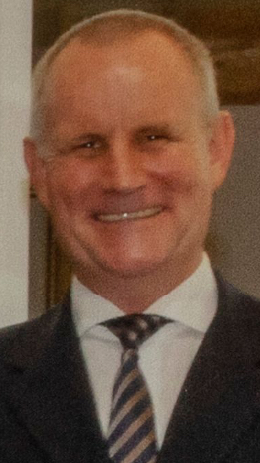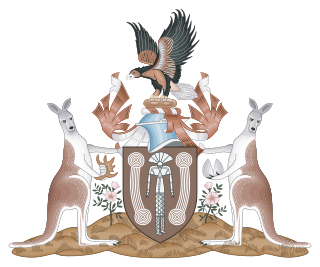
The Family Court of Australia was a superior Australian federal court of record which deals with family law matters, such as divorce applications, parenting disputes, and the division of property when a couple separate. Together with the Federal Circuit Court of Australia, it covered family law matters in all states and territories of Australia except for Western Australia, which has a separate Family Court. Its core function was to determine cases with the most complex law, facts and parties, to cover specialised areas in family law, and to provide national coverage as the national appellate court for family law matters.
John Jeremy Doyle,, Australian jurist, was the Chief Justice of the Supreme Court of South Australia, the highest ranking court in the Australian State of South Australia, between 1995 and 2012.
Puisne judge and puisne justice are terms for an ordinary judge or a judge of lesser rank of a particular court. The term comes from a combination of the two French words, puis, "since, later" + né, and "born", which have been combined as French: puisné or puîné; meaning "junior".
The judiciary of Australia comprises judges who sit in federal courts and courts of the States and Territories of Australia. The High Court of Australia sits at the apex of the Australian court hierarchy as the ultimate court of appeal on matters of both federal and State law.

The Supreme Court of the Australian Capital Territory is the highest court of the Australian Capital Territory (ACT). It has unlimited jurisdiction within the territory in civil matters and hears the most serious criminal matters.

Johan Wessel Elferink is an Australian politician. He is a former member of the Northern Territory Legislative Assembly for the Country Liberal Party.
Casuarina is one of the northern suburbs of Darwin, the capital of the Northern Territory of Australia. It is the traditional country and waterways of the Larrakia people.

The criminal law of Australia is the body of law in Australia that relates to crime.

The Federal Court of Australia is an Australian superior court which has jurisdiction to deal with most civil disputes governed by federal law, along with some summary and indictable criminal matters. Cases are heard at first instance mostly by single judges. In cases of importance, a Full Court comprising three judges can be convened upon determination by the Chief Justice. The Court also has appellate jurisdiction, which is mostly exercised by a Full Court comprising three judges, the only avenue of appeal from which lies to the High Court of Australia. In the Australian court hierarchy, the Federal Court occupies a position equivalent to the supreme courts of each of the states and territories. In relation to the other courts in the federal stream, it is superior to the Federal Circuit and Family Court of Australia for all jurisdictions except family law. It was established in 1976 by the Federal Court of Australia Act.
The Youth Justice Court of the Northern Territory is an Australian court which hears and determines cases concerning crimes committed by children under the age of 18 years in the Northern Territory.

The Local Court of the Northern Territory is one of two levels of court in the Northern Territory of Australia. It has jurisdiction in civil disputes up to A$250,000, and in criminal cases in the trial of summary offences, and also deals with preliminary matters for indictable offences which are then heard by the Supreme Court of the Northern Territory. There are local courts held in Darwin, Alice Springs, Katherine, Tennant Creek, and some "bush courts" in remote locations.
The Supreme Court of the Commonwealth of the Northern Mariana Islands, 1 CMC § 3101, is the highest court of the United States Commonwealth of the Northern Mariana Islands (CNMI), exercising civil and criminal appellate jurisdiction over commonwealth law matters. It should not be confused with the District Court for the Northern Mariana Islands, which exercises jurisdiction over federal law. The Supreme Court sits in the capital, Saipan, and consists of a Chief Justice and two Associate Justices. The CNMI has no intermediate appellate commonwealth law court, which means that the CNMI Supreme Court hears appeals directly from the trial-level Superior Court.
John David Phillips KC is an Australian lawyer and judge who served on the Supreme Court of Victoria from 1990 to 2004.

Coolalinga is an outer suburban area in Darwin. It is 29 kilometres (18 mi) south east of central Darwin, 10 kilometres (6 mi) south east of Palmerston and 6 kilometres (4 mi) east of the proposed city of Weddell. Its Local Government Area is the Litchfield Municipality. The name was first used by Len Cant for his store and caravan park on the Stuart Highway. Since Coolalinga Store, the area has become an important commercial centre for the Shire.
Ewan Charles Crawford, is an Australian judge and former Chief Justice of Tasmania.
Life imprisonment is the most severe criminal sentence available to the courts in Australia. Most cases attracting the sentence are murder. It is also imposed, albeit rarely, for sexual assault, manufacturing and trafficking commercial quantities of illicit drugs, and offences against the justice system and government security.
Circuit riding was one of the responsibilities of U.S. Supreme Court justices during the Marshall Court (1801–1835). Under the Judiciary Act of 1801, the United States federal judicial districts were divided into six United States circuit courts—one for each justice. Rather than appointing separate circuit judges, the circuit courts were staffed by a combination of the resident United States district court judges from that district and the Supreme Court justice assigned to that circuit.

Pine Creek railway station is a disused railway station and museum on the former North Australia Railway in Pine Creek in the Northern Territory of Australia. The station is located 235 km (146 mi) from the original Darwin station, and was the southern terminus of the line until 1914. The station precinct is the most complete remaining example of infrastructure associated with the line.
John Dominic Burns is an Additional Judge of the Supreme Court of the Northern Territory, a former Judge of the Supreme Court of the Australian Capital Territory and a former Chief Magistrate of the Australian Capital Territory.
Phillip George Evatt, was an Australian naval officer and jurist who serviced as a judge on the Federal Court of Australia from 1977 to 1987. Evatt received a Bachelor of Laws from the University of Sydney. He served as lieutenant in the Royal Australian Navy from 1940 to 1946, including on the British submarine HMS Tapir. He was awarded the Distinguished Service Cross for his part in the sinking of German submarine U-486 in 1945. Evatt was admitted as a barrister in New South Wales in 1951. During his career as a jurist, he served on several courts, including the Supreme Court of the Northern Territory (1976–1987), the Supreme Court of the Australian Capital Territory (1974–1987), and the Supreme Court of Norfolk Island (1981–1987). Evatt presided over a Royal Commission into the use of chemical agents in the Vietnam War.









